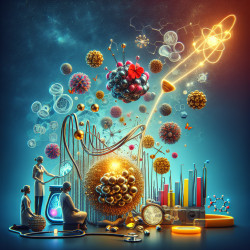Introduction
As practitioners dedicated to improving the outcomes for children, we constantly seek innovative ways to enhance our therapeutic approaches. One promising development in the field of nanotechnology is the use of gold-silver alloy nanoshells, as explored in the research article "Gold-silver alloy nanoshells: a new candidate for nanotherapeutics and diagnostics." This breakthrough offers exciting possibilities for improving MRI imaging and reducing toxicity, which can have significant implications for pediatric therapy.
Understanding Gold-Silver Alloy Nanoshells
Gold-silver alloy nanoshells are an innovative type of nanoparticle designed to enhance magnetic resonance imaging (MRI) by acting as dual T1 and T2 contrast agents. These nanoshells are created by coating Gd-doped iron oxide cores with a gold-silver alloy shell, effectively sequestering toxic Gd ions within the core. This design aims to mitigate the toxicities associated with traditional gadolinium-based contrast agents, such as nephrogenic systemic fibrosis.
Potential Applications in Pediatric Therapy
In pediatric therapy, particularly in speech-language pathology, accurate and safe imaging is crucial for diagnosing and monitoring conditions that affect speech and language development. Gold-silver alloy nanoshells offer several advantages:
- Enhanced Imaging: The dual contrast properties of these nanoshells improve the clarity and detail of MRI scans, providing better insights into neurological conditions that may impact speech and language.
- Reduced Toxicity: By sequestering Gd ions, these nanoshells reduce the risk of toxicity, making MRI a safer option for children, especially those with compromised renal function.
- Therapeutic Potential: Beyond imaging, the optical properties of these nanoshells suggest potential applications in tumor cell ablation, offering a dual diagnostic and therapeutic tool.
Encouraging Further Research
While the current research highlights the potential of gold-silver alloy nanoshells, further studies are essential to fully understand their applications in speech therapy. Practitioners are encouraged to explore the following areas:
- Investigate the long-term effects and safety of using these nanoshells in pediatric populations.
- Explore the integration of nanoshell-enhanced imaging into existing diagnostic protocols for speech and language disorders.
- Collaborate with interdisciplinary teams to assess the therapeutic applications of these nanoshells in related fields.
Conclusion
Gold-silver alloy nanoshells represent a promising advancement in the field of nanotechnology with potential applications in pediatric speech therapy. By enhancing imaging and reducing toxicity, these nanoshells could significantly improve diagnostic accuracy and therapeutic outcomes. As practitioners, staying informed about such innovations and engaging in further research will enable us to provide the best possible care for children.
To read the original research paper, please follow this link: Gold-silver alloy nanoshells: a new candidate for nanotherapeutics and diagnostics.










